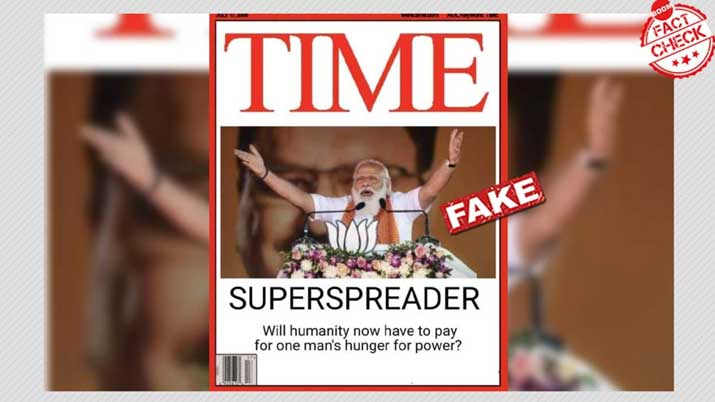As the number of COVID cases surge in the country, and the grim statistic of two lakh deaths due to COVID were recorded on Wednesday, 28th April. A viral photo showing a TIME Magazine cover with Prime Minister Narendra Modi’s photo calling him a ‘superspreader’ is fake. While the global media has criticised PM Modi for his handling of the coronavirus pandemic, this TIME’s cover is morphed.
Super Spreader, according to Merriam Webster dictionary, is an individual who is highly contagious and capable of transmitting a communicable disease to an unusually large number of uninfected individuals. The word ‘super spreader’ has become well known ever since the start of the COVID-19 pandemic. In relation to the ongoing pandemic, this post has been circulating widely.
This is being shared in the backdrop of PM Modi earlier receiving criticism over addressing election rallies in West Bengal as the state sees a massive rise in COVID-19 cases. The Election Commission of India on April 24, 2021, banned road shows and vehicle rallies in West Bengal and said no public meeting having more than 500 people would be allowed.
The date at the top of the viral image says, ‘July 17, 2006’. On looking up on the cover for the date on TIME magazine’s archive, called Vault. A cover for that particular date was found that is “The End of Cowboy Diplomacy”, with an image of a cowboy hat and boots. The date at the top, along with the text, “www.time.com AOL Keyword: TIME” was written the same as the viral image. An online tool called ‘Kapwing’ was retrieved that allows users to recreate the TIME magazine cover, whose template matched the viral image.
The original image is traced back to 25 February 2021, when the Prime Minister had addressed a public meeting in the poll-bound Puducherry. The image was taken by photographer R Senthil Kumar and can be found in news agency PTI’s archives. Thus, an image of PM Modi has been morphed onto the template to mislead the public.


